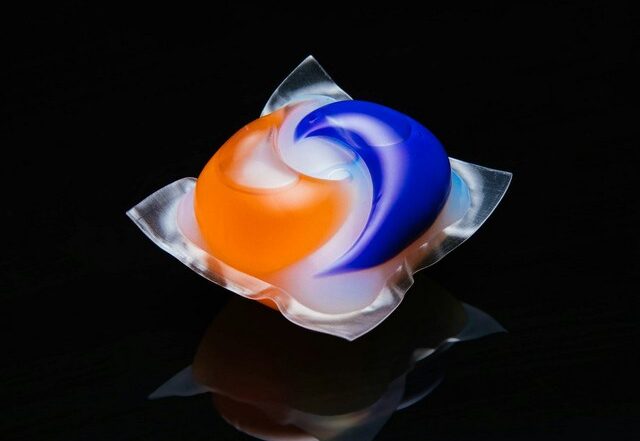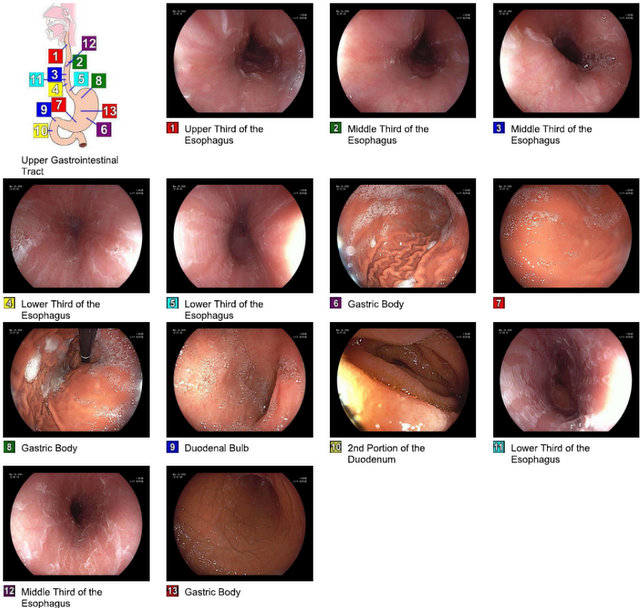Case
A teenage female was brought in by ambulance after intentionally ingesting three liquid Tide pods. She had a prior history of self-harm but no other significant past medical history. Approximately 90 minutes prior to arrival, the patient had cut open three Tide pods and drunk their contents, immediately followed by a glass of apple juice and half a glass of water. She vomited shortly afterward, then developed a sore throat, chest pain, and abdominal pain. She told her father what she had done an hour after the ingestion and was brought to the emergency department.
Patient evaluation was notable for tachycardia with a heart rate in the 110s, BP 148/107, abdominal tenderness in the left upper quadrant, hoarse voice, and erythema in the posterior oropharynx. Bedside pharyngoscopy was performed and showed mild edema of the oropharynx without necrosis.
A chest x-ray showed possible right lower lobe pneumonitis. Lab work was notable for a lactate of 3.4 but was otherwise unremarkable. The patient remained hemodynamically stable in the emergency department, vomited Tide-scented emesis once, and continued to have throat and abdominal pain. She was started on pantoprazole and admitted to the pediatrics service.
Endoscopy the following day was notable for mild sloughing of the entire esophagus (Figure 1). Biopsies were obtained and showed normal esophageal tissue. Lactate normalized by the next morning. No respiratory symptoms were observed during the patient’s hospital stay making it unclear if the pneumonitis finding on x-ray was incidental or related to the Tide pod ingestion. The patient’s diet was advanced over the next two days before eventual discharge to a psychiatric hospital on hospital day three with an eight-week course of pantoprazole.
Discussion
Laundry pods were introduced to the US market in the 2010s as a more convenient detergent delivery option. Concerns about their visual similarities to candy and potential health hazards from ingestion have followed the product since its creation. The peak of this concern came in early 2018 when the “Tide Pod Challenge” began to circulate on social media; most commonly on Tik-Tok. The challenge consisted of taking Tide pods and either biting into them as if they were candy or swallowing small portions.
Other chose to show ways to prepare the Tide pods by cooking them. This meme resulted in an increase in poison center calls for accidental and intentional laundry pod ingestions [1]. Public interest in the potential dangers of laundry pods has since decreased, but cases of accidental and intentional ingestion still occur. Knowledge of the pathophysiology and correct management is important for emergency physicians.
Laundry pod ingredients can vary depending on the manufacturer, but the primary ingredients of concern are the ethoxylated alcohols which act as a surfactant to remove dirt, and propylene glycol, which is a solvent used to dissolve the other pod contents including surfactants, cellulase enzymes, and colorants. While pH of laundry pods is often assumed to cause their caustic effects, the pH of Tide pods is around 6.8-7.4 and is not significantly acidic or alkaline [2,3]. It is instead the highly concentrated surfactants, including alcohol ethoxylates and several hydrocarbons, in the laundry pods that may cause respiratory damage by interfering with surface tension in the alveoli and that damage of the esophageal mucosa [4,5].
Propylene glycol plays an insidious role in laundry pod toxicity as it can cause CNS depression and lactic acidosis. CNS symptoms are not often associated with laundry pod ingestion. Per the safety data sheet for Tide pods, propylene glycol makes up 15-20% of the solution by weight [2,3] Meaning that each laundry pod has a potential propylene glycol dose of 325-430 mg/kg in a 60 kg adult or 975-1290 mg/kg in a 20 kg child.
While there is not a well-established oral toxic dose of propylene glycol, there has been a prior report of a pediatric patient experiencing significant CNS depression at an estimated oral dose of 150-200 mg/kg in a hair gel product [6]. It is unlikely that young children most at risk of this toxicity would consume a significant quantity of laundry pods given their unpleasant taste, but with intentional ingestion toxicity becomes more likely.
Management in laundry detergent ingestion cases is primarily supportive. It is important to recognize that a normal oropharyngeal exam does not exclude esophageal damage, and it is reasonable to pursue endoscopy for further evaluation. There is no clear consensus on whether endoscopy is required in all cases. Based on case series and retrospective review a about one quarter of patients had endoscopic findings with eighty percent of symptomatic patients showing findings [7,8]. There are no documented cases of long-term complications from this damage such as perforation or strictures [7]. However, there has not been robust follow-up and given the small patient population long term sequalae are not well known.
Given the paucity of data and the potential for significant injury it is reasonable to discuss endoscopy for symptomatic patients. Reports of gastric or intestinal mucosa damage after ingestion are also not well documented. The patient in the presented case had mild mucosal sloughing of the entire esophagus, consistent with her ingestion. She had a good outcome and may have minimized damage to her esophagus by diluting the contents of the laundry pod by drinking apple juice and water immediately after her ingestion.
Conclusion
Laundry pod ingestion is a relatively uncommon toxic exposure that lacks clear guidelines on management. The case presented here highlights the possibility of detergent pod ingestion as a mechanism for self-harm. A prior study on detergent capsule exposure noted that ninety-six percent of calls made to the poison center concerned children five years of age or younger [9].
There is no clear data on the average volume of ingestion for these cases. Intentional ingestion in the older pediatric population has the potential to involve higher volume and the risk for increased local tissue damage compared to young children more likely to dislike the bitter taste of laundry pods.
The toxic mechanisms of laundry pods are primarily related to the high concentrations of surfactants and propylene glycol contained within them. Neurologic and respiratory symptoms are the most common sequelae of laundry pod ingestion. Management continues to consist of supportive care. With consideration of endoscopy for symptomatic patients. Asymptomatic patients have a much lower correlation with esophageal injury [8].
Data on similar pediatric caustic ingestions involving lye and dishwasher detergents showed no benefit to endoscopy in asymptomatic patients [10]. Given the lack of significant sequalae documented in prior case series it is reasonable to discharge asymptomatic patients home after an observation period of several hours with clear return precautions if any delayed symptoms develop. Any cases raising concern for the volume of ingestion or clinical uncertainty regarding need for prolonged observation would benefit from discussion with a toxicologist given the paucity of data.
References
- Marshall RD, Bailey J, Lin A, et al. Impact of social media “challenges” on poison center case volume for intentional ingestions among school-aged children: an observational study. Clin Toxicol. 2024;62(3):183-189.
- P&G. Tide Pods Original Safety Data Sheet. March 6th, 2015. Accessed April 22, 2025. {https://www.savergroup.com/wp-content/uploads/2019/04/Tide-Pods-Original-1.pdf [savergroup.com]}
- Day R, Bradberry SM, Thomas SHL, Vale JA. Liquid laundry detergent capsules (PODS): a review of their composition and mechanisms of toxicity, and of the circumstances, routes, features, and management of exposure. Clin Toxicol. 2019;57(11):1053-1063.
- G. Kuz’mina, V.I. Kryuchkova. Effect of Injection of synthetic detergent into the trachea and lung on basic pulmonary functions and surface tension of lung extracts. Bulletin of Experimental Biology and Medicine. 1974 May; 77:470-472.
- Sjogren, P.P., Skarda, D.E. and Park, A.H. (2017), Upper aerodigestive injuries from detergent ingestion in children. The Laryngoscope, 127: 509-512.
- Glover ML, Reed MD. Propylene glycol: the safe diluent that continues to cause harm. Pharmacotherapy. 1996 Jul-Aug;16(4):690-3.
- Smith E, Liebelt E, Nogueira J. Laundry detergent pod ingestions: is there a need for endoscopy? J Med Toxicol. 2014 Sep;10(3):286-91.
- Sing A, Anderson M, Altaf MA. Clinical and endoscopy findings in children with accidental exposure to concentrated detergent pods. J Pediatr Gastroenterol Nutr. 2019 Jun;68(6):824-828.
- Williams H, Bateman DN, Thomas SH, Thompson JP, Scott RA, vale JA. Exposure to liquid detergent capsules: a study undertaken by the UK national poisons information service. Clin Toxicol. 2012 Sep;50(8):776-80.
- Christesen HB. Prediction of complications following unintentional caustic ingestion in children. Is endoscopy always necessary? Acta Paediatr. 1995 Oct;84(10):1177-82.




